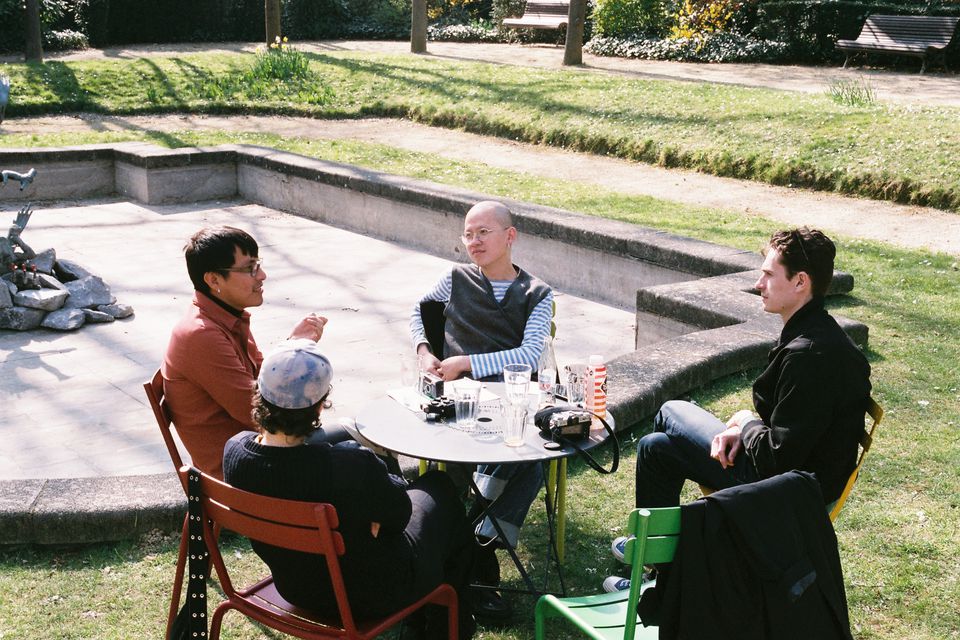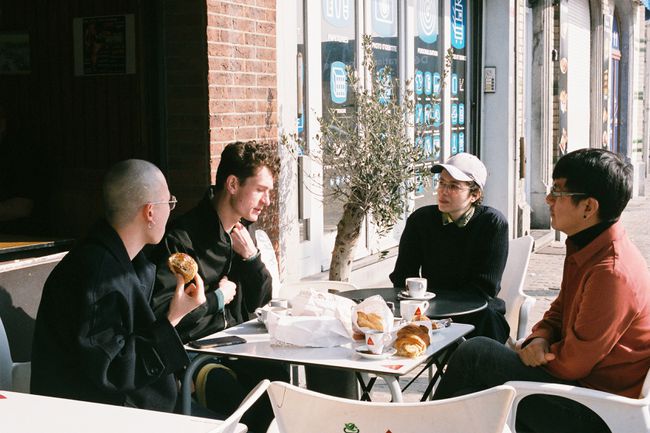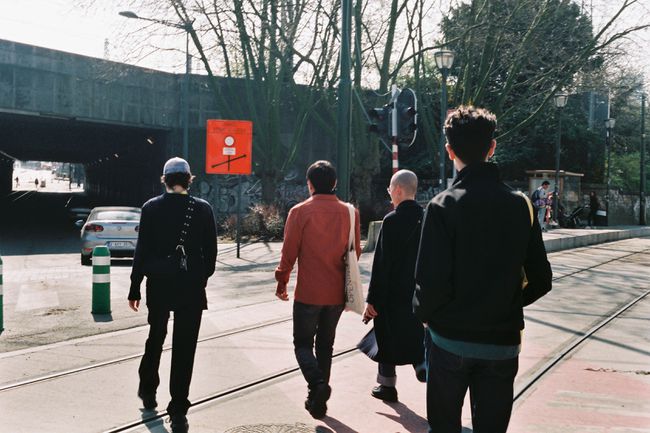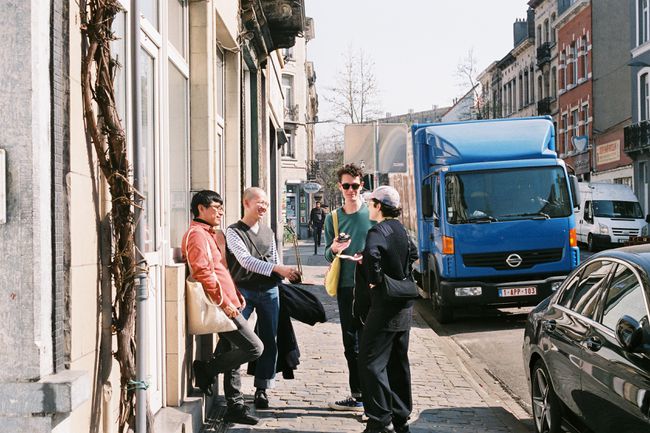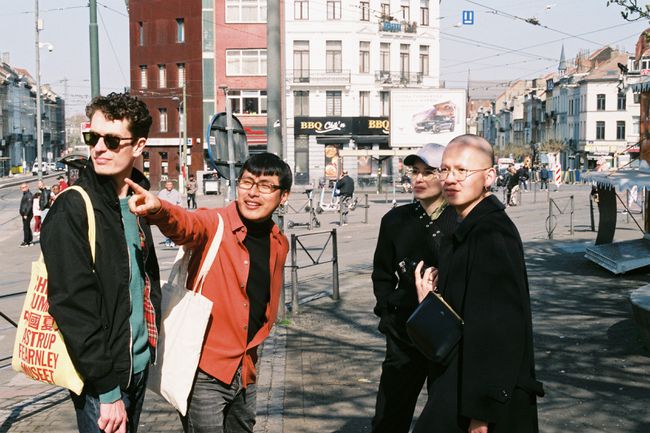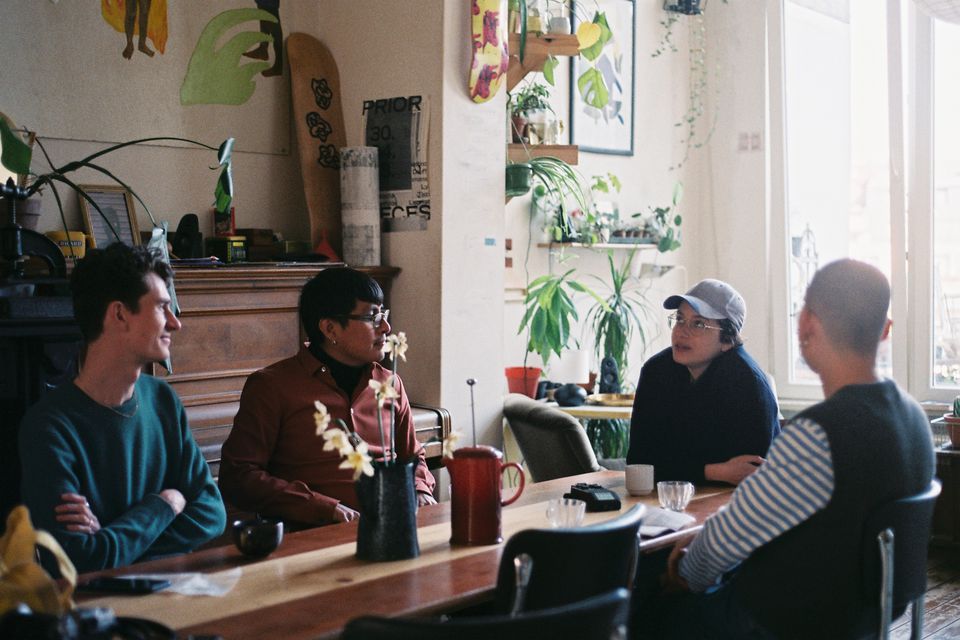Brussels: Struggles, Memories of Shared Experiences, and Queer Tactics of Resistance
Bui Quy Son and Paul-Antoine Lucas of Exutoire in conversation with Léa Brami and Alexander Auris about the need for queer failures and the potential of a post-binary, queer world
Brussels, 9:30am, terrace of La Perle
The recorder was sitting on the table of the café as Alexander, Léa, and the two of us enthusiastically discussed their respective quests for queerness in art and architecture. Together, we spent the day strolling around the neighbourhoods of Laeken and Schaerbeek, learning about Brussels through Alexander’s and Léa’s eyes and stories—from the bustling market of Place Bockstael and the busy Place Liedts to the associative space of Brave and Léa’s home. Alexander’s and Léa’s different experiences brought us to debate the struggles of searching for belongingness in the city, the vulnerability of young practitioners finding their voices, and the future of their practices.
- PAL
- Hi Alexander and Léa. Who are you and what brought you to Brussels? What got you interested in the queer in architecture, and with that interest in mind, what has your lived experience of the city been like?
- AA
- I’m a Peruvian architect and I came to Brussels four years ago for my master’s. During my earlier education, I was quite miserable, and I promised myself that from then on, I would only work on topics that really interest me, issues that I can really contribute to. During my studies, I found the freedom and support to develop my own ideas. For my thesis, I began to research queerness and how my own queerness relates to my understanding of space.
- LB
- I’m an artist, architect, and writer and my practice takes form as installation, performance, teaching, art textile, and serigraphy. I came to Brussels because I wanted to study art and I didn’t see myself living in Paris anymore.
My practice started with a lot of anger. When I was 22, studying architecture, I began to notice how damaging patriarchy had been to my life and body. I was also depressed by my architectural studies, by the school, and didn’t relate to the knowledge my teachers were sharing. When I was very young, museums felt like a safer place. But during this personal breaking point, at 22, I discovered that there was a lot of institutional violence in museums, a lot of sexism, so for my master’s thesis, I proposed a manifesto for a new form of museum through a feminist perspective. It was a way to turn my anger into something more beautiful, something that made sense for me. That’s how my practice was born. My goal was not to create a queer practice; it was to create architecture that could modulate, free, and emancipate us. - BQS
- How does the city influence your practice and research around queerness in architecture?
- AA
- It always takes time to build a network of friends, a network of safe spaces and people you feel comfortable with. It took me a while to find a place in Belgium. It was maybe only one year ago that I started to push myself to meet and connect with new people and the things the city has to offer. From my observations, students often come and then stay as artists or architects, but most of us struggle to find good jobs, to be paid properly. We love the work but we’re vulnerable. That’s probably why we try to connect with other people, to collaborate. It’s sad to think that the energy of the city might be a product of that vulnerability.
- BQS
- You seem to speak of Brussels more as a meta-city than a physical place. It’s where you build your social network and infrastructure.
- AA
- My problem is that I always forget to be an architect; currently I tend to relate more to performance and bodies. The physical space is sometimes just the container where interactions happen. That’s why I like where we are right now, La Perle café—at night, when the party starts but also during the day because of Bockstael square, which the café faces. In Brussels, there are different markets that occur once or twice a week, and they move between different squares. I think the markets are a representation of this super diverse city, this migrant city, in the way that they appear, disappear, and move. I find that very peculiar in contrast to where I come from. In Brussels, precarity is very visible. It’s in front of your eyes all the time, and I like to be in places where it’s not hidden. It allows for a lot of things to happen that couldn’t in another city.
- PAL
- When discussing what queerness is in architecture, there’s often this idea of a queer methodology, a queer approach to space-making, the creative process, or theoretical thinking. As a queer person that has to go through the process of coming out, you have to constantly be aware of your own presence in space and how people look at you. So, if you’re a queer designer or architect, you often intuitively think about how you place people in a space where they’ll be looked at.
This duality of perspective creates a special self-awareness, intuitive inclusivity, a need to constantly make people feel welcome in the space you create. You want to make sure they will not be judged when entering it. This can appear in different ways—in the approachability of the architecture’s aesthetics, in its ecological preoccupations, in an architecture weird and strange enough as to make everything acceptable. By creating discomfort, this sort of work puts everyone (or most) on the same level. - LB
- I agree. When I think about what it is to have a queer approach, I think about capitalism, racism, ability, and not just about whether I’m bi or non-binary. We are all suffering the impacts of systems, so we can all reproduce oppression and need to be aware of it.
Part of my work is about collective memory, how we can preserve our tactics, our knowledge, all the things that we learn and discover, everything we create as a community. I really believe that having artefacts, places, or rituals is a good way to keep our knowledge. When stories are told time and time again, they tend to disappear because there is nothing to be a receptacle for them. In my work, I re-create and manipulate memory with fake artefacts and rituals that I imagine have happened. It’s a sort of restorative act. - AA
- When I started building my practice, I wanted my research to be as inclusive as possible and decided not to work on physical spaces but on experiences. I asked, for example, how does my experience as a queer person in Peru relate to that of a queer person in Belgium or in France? I defined three spheres, three stages in the process of being queer in the world.
The first one involves realising that you are different in this heteronormative world. That experience of realization happens everywhere, and that brings us together on a certain level. I want to analyse the spaces that allow for that realization. I call this queer space the “affective sphere.” The second sphere involves looking for people like you and realizing those interactions can happen in virtual space as well as physical space. This second layer, the “XXXXX-sphere,” can happen in public, private, or virtual spaces, depending on the city. The third of these spheres is the “political sphere.” Here you decide how you want to present yourself in your everyday public life. The idea of being out or not is a political decision related to public spaces and spaces of power. The political sphere includes the timeline of political and historical events of each culture or city that has allowed us to live in this specific moment and environment, to be out or not.
This idea of realization of the self, of recognition in others, and of openness to others and public life comes from my own queer experiences. Now, I’m interested to see how I can use this research and translate it into physical interventions in space, to add a new layer in my architectural practice. - LB
- I think physical space is important. The argument I made at the end of my studies is that maybe the only architecture that is adaptable to upheavals is the body. When confronted with something unfamiliar, you can change your habits, develop other gestures, and create another way to act and relate to other people. In order to do that, we need spaces that challenge who you are and allow you to connect with other people. But queer design tends to crystallize things too neatly; what’s more important is a queer practice, a queer gaze, that allows us to build differently.
- BQS
- Sometimes, the programmatic subversion of an existing space could be associated with a certain queerness. Is it possible to design or queer spaces that are already institutionalized? Or do we need to design or create new typologies of space?
- PAL
- I do feel that it is still important to attempt to build spaces through a queer lens, to fail at it and have bad examples. This also creates a memory, something to build upon. This has the potential to have disciplinary influence and change the urban spaces of our cities. This could also challenge our outdated methodologies as architects. Would you be interested in an opportunity to design an intervention that would be related to these artifacts in a more spatial manner?
- LB
- Sometimes I’m too afraid to fail. It’s a lot of responsibility to build something; maybe that’s why I make art. If I realise that I oppress someone or push a body to act in a certain way, it would be difficult for me to grapple with. But you’re right, we do need some people who have a queer architectural practice, who are in the process of making, failing, creating, and re-creating.
- PAL
- In our practice, we also want to be criticized. We want to exist first, be visible and see what that creates. I think a queer practice needs to be criticised, to be constantly rethought—a process of building and unbuilding. It might be challenging but that’s what’s nice about it.
Let’s go back to spaces of resistance, the need for memory, safer spaces. For memories to be collective, for collective knowledge to be shared, stewardship seems necessary. Katarina Bonnevier talked a lot about that. It’s not only about building a queer pavilion and putting it on the central square; it’s about who’s going to activate or maintain that pavilion. This act of stewardship is also a queer act. If you were to redesign a public square for instance, how do you make sure to involve the community that will use it and take ownership of it? - BQS
- Queer practices also come down to practices of care. A lot of it is not only about how to provide the infrastructure, but how to keep it alive.
- LB
- And we didn’t learn that in architecture school. What we miss in our practice are all the gestures related to maintenance, cleaning, logistics, and all the people who organise. We ignore them, but without them, we are nothing, and our buildings would be nothing.
- BQS
- With that in mind, I wonder what you do to maintain your own practices. What is your economic model? How are you surviving?
- AA
- I work as an architect in Brussels and this allows me to pay for my living expenses. On the side, I do personal research and divide my time between artistic projects in different formats: movies, workshops and lectures. Since I received a grant from the Flemish government, I was able to develop my research in the framework of an elective course at the Faculty of Architecture of KU Leuven.
- LB
- I think it’s important to talk about this; it’s a part of our practice and it’s a reality. For me, it’s uglier than it is for Alex because I work at a café. I decided to do bread-and-butter work, a job that pays my bills. I became a waiter, because my income was very unstable. Sometimes, I only earn enough money to live for a month, and sometimes I only have a hundred euros from my practice. Because I realize and pay for my projects on my own, I need money to buy textiles or resin, and it’s very expensive. I’m currently applying for a residency and a grant because it’s very difficult to have a practice when you have a side job. You’re always tired, you put so much energy into something meaningless. After we finish talking today, I’ll go to work, for my cleaning shift at the café.
- PAL
- How do you see your practice evolving in the near future? What futures—both ideal and realistic—do you imagine for your practice?
- AA
- My next ambition is to go on to spatial interventions, to physical architectural representations and experiments, but I also want to continue my research on “Queer Commons.” The future also involves me getting my license in architecture. After that, I’ll continue experimenting with design through competitions, and I hope that will allow for other possibilities.
- BQS
- Would you want to continue your academic research in parallel with building?
- AA
- Yes, because I don’t agree with this idea of theory and practice being independent from one another. I’m only interested in doing academic research if it’s going to be translated into practice.
- LB
- I hope I will soon have decent material conditions for my practice, that I won’t need a side job anymore. But I will not tell you what I think about my future [laughs]. I have a precise idea of what I dream about and what I want, but it’s better to let it stay a secret, because I want to have it for myself. [laughs].
- BQS
- Fair enough. But at least you know what you want to do for now: to get out of this survival mode, which I think is going to be a big step.
- PAL
- So, last question: What would be the ideal conditions—social, political, environmental, ideological—for a queer practice of architecture? Is there something you would change radically, or something new you can inject?
- LB
- This question is not fun. When I read it, I was like, “Oh my God! I don’t know!”
- AA
- I think we all have to realize in the future that we are all queer [laughs]. We actually don’t know that we are not static, that we move and that we’re all always fluid. It’s just about realizing it and being more open.
This is the second in a series of three articles conceived by Exutoire titled “Queer Practices in Architecture: New Views from Stockholm, Brussels, and Paris.”
